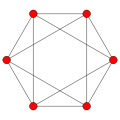Antiprism graphIn the mathematical field of graph theory, an antiprism graph is a graph that has one of the antiprisms as its skeleton. An n-sided antiprism has 2n vertices and 4n edges. They are regular, polyhedral (and therefore by necessity also 3-vertex-connected, vertex-transitive, and planar graphs), and also Hamiltonian graphs.[1] ExamplesThe first graph in the sequence, the octahedral graph, has 6 vertices and 12 edges. Later graphs in the sequence may be named after the type of antiprism they correspond to:
Although geometrically the star polygons also form the faces of a different sequence of (self-intersecting) antiprisms, the star antiprisms, they do not form a different sequence of graphs. Related graphsAn antiprism graph is a special case of a circulant graph, Ci2n(2,1). Other infinite sequences of polyhedral graph formed in a similar way from polyhedra with regular-polygon bases include the prism graphs (graphs of prisms) and wheel graphs (graphs of pyramids). Other vertex-transitive polyhedral graphs include the Archimedean graphs. References
External links |
Portal di Ensiklopedia Dunia



















